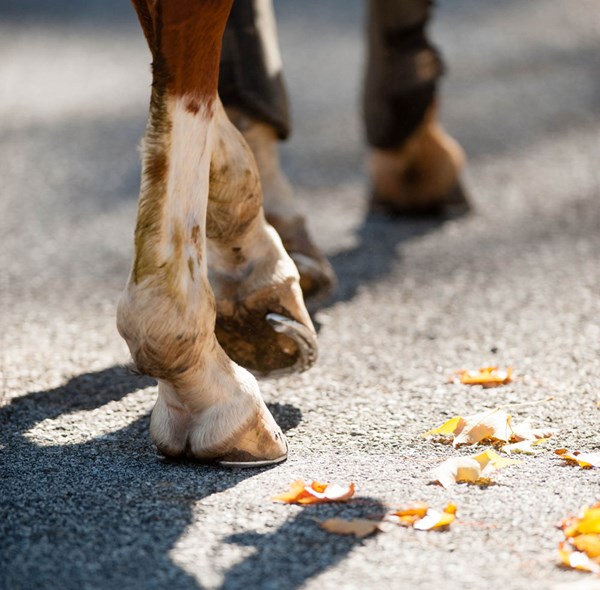 If you plan to do roadwork with your horse on paved surfaces, inspect them carefully before hitting the road. Some asphalt is covered with a slick coating, which may cause dangerous slips or even falls. | © Amy K. Dragoo
If you plan to do roadwork with your horse on paved surfaces, inspect them carefully before hitting the road. Some asphalt is covered with a slick coating, which may cause dangerous slips or even falls. | © Amy K. DragooQ: This is my first season eventing at Preliminary level and I’m learning some new techniques for getting my horse fitter. I’ve heard of several trainers who trot their horses on hard-packed dirt roads to strengthen their legs. I was always told that the concussion of trotting on roads is bad for horses’ legs. Was that an old wives’ tale?
LAURA WERNER, DVM
A: Walking and trotting horses on firm footing is a common practice that racing, foxhunting and eventing trainers have used for years, particularly in Europe. Their reasoning is that the physical stress caused by controlled amounts of concussion stimulates the tendons and ligaments to grow stronger during a young horse’s development. Scientific studies have shown that early exercise, though not specifically on roads, is critical to tendon development in young horses. Careful, controlled roadwork can be an acceptable component in a training program aimed to promote such healthy development.
For mature and aging horses, however, roadwork offers a mixed bag of pros and cons. In the wintertime and early spring, it can be a good alternative for fitness work when other outdoor riding areas are too muddy or icy. It also provides a nice change of scenery. For eventing specifically, roadwork helps to expand horses’ and riders’ familiarity with different types of footing. When galloping across country, eventers need to be ready to handle a variety of surfaces and uneven terrain.
Horses recovering from soft-tissue injuries can benefit more from walking and trotting on firm footing, such as packed dirt roads, than from working on deep, soft footing. The latter can add more strain to tendons and ligaments and thus slow the rehabilitation process or, worse, risk re-injury.
Unfortunately, roadwork also has its downsides. It can cause excessive stress and strain on joints, particularly in older horses. It can also aggravate hoof problems. Many horses do not have strong enough feet to withstand the pounding on hard roads. It’s very important, therefore, to consult your veterinarian about your horse’s individual needs before carefully weighing the benefits and drawbacks of roadwork.
If your veterinarian gives you the OK to ride your horse on roads, select safe, quiet ones with limited, slow-moving traffic, good surfaces, wide shoulders and, if possible, no loose neighborhood dogs. An ideal road surface is hard-packed dirt that still has a little give. If you’re lucky enough to be near a beach, the firm sand along the waterline is also a good surface to work on. If your choices are limited to paved roads, inspect their surfaces carefully. Some asphalt is covered with a slick coating, which may cause dangerous slips or even falls. Ask your veterinarian and farrier if they recommend additional traction for working on your local roads. Putting a little borium—a granular metal treatment—on your horse’s shoes may help to prevent accidents and injuries.
If you decide to do roadwork, think of it as part of his routine fitness program, limiting its frequency in the same way you limit his speed work. When preparing for a competition, upper-level horses may do it every five days while most lower-level horses generally do it no more than once a week. As with all of your other fitness work, start slowly and gradually increase the duration of your workouts. Check your horse for any signs of problems after each session. Contact your veterinarian if you notice swelling in his legs or lameness.
If you and your veterinarian decide that the concussion from trotting on roads is inadvisable for your particular horse, consider walking on them instead. This produces far less concussion but still provides great benefits. Walking exercise, no matter what type of footing you’re on, for 30 minutes before or after a dressage school, for example, will help to increase your horse’s cardiovascular and muscular fitness. And it’s safe to do it as often as several times a week.
Laura Werner, DVM, MS, Diplomate, American College of Veterinary Surgeons, is a veterinary surgeon specializing in lameness and equine emergency servi-ces. After veterinary school, she completed her surgical internship at Hagyard Equine Medical Institute in Lexington, Kentucky, followed by a residency and master’s degree program at The Ohio State University. She then taught at Ohio State for over a year before joining a private practice in central California, where she performed surgery for six years. In 2011, she joined the Hagyard Equine Medical Institute’s Davidson Surgery Center as a surgery associate. In addition to her surgical duties, she is continuing research on septic arthritis and osteomyelitis.
An event rider with experience at the Preliminary level, Dr. Werner enjoys “living vicariously through others” by treating mounts of her fellow competitors, including Young Riders and Olympians. She also serves as an FEI (International Equestrian Federation) veterinary delegate at some of the top U.S. events.
This article originally appeared in the August 2015 issue of Practical Horseman.










